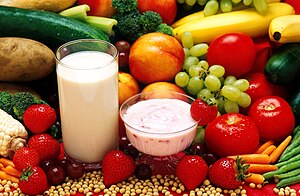Sunday, May 13, 2012
 A diet rich in soy and whey protein, found in products such as soy milk and low-fat yogurt, has been shown to reduce breast cancer incidence in rats. (Photo credit: Wikipedia)
A diet rich in soy and whey protein, found in products such as soy milk and low-fat yogurt, has been shown to reduce breast cancer incidence in rats. (Photo credit: Wikipedia)Living a low-calorie lifestyle means adopting healthier eating and exercise habits for the rest of your life. It starts with a diet plan that cuts back on the number of calories you’ve been consuming so that you can achieve a healthier weight. Your new diet plan is designed to help you lose weight safely and effectively, and to grow into a lifelong plan for weight maintenance.
A safe low-calorie diet not only supplies enough energy to get you through each day, but it also provides the essential nutrients you need to get from food to stay healthy. The fewer calories you consume, the harder it is to get enough of those essential nutrients. The way to get the most nutritional value from your diet at any calorie level is to eat a well-balanced diet that contains a wide variety of foods. In Chapter 3, you find more information about the nuts and bolts of a nutritionally sound low-calorie diet.
Knowing exactly how many calories actually go into a low-calorie diet is also crucial. Chapter 6 contains four weeks of daily menu plans that contain from 1,000 to 1,500 calories a day. You may be thinking these menus contain the maximum number of calories you need to consume on a low-calorie diet, but in fact, I call them minimum-calorie menus. Yes, you need to put a top limit on your daily calories when you’re on a low-cal diet to lose weight. But you need to put a bottom limit on your calorie count too, because if you go too low, you’ll just trip yourself up. You’ll find yourself caught in the type of starve/binge cycle that sabotages many a dieter’s best intentions. When you start cutting calories, you can work within this range of 1,000 to 1,500 calories because most people can lose weight in this range. The top of this range (1,500 calories) may even be too low for you. If that’s the case, you can add calories back in until you get to a point where you’re more satisfied with the amount of food you’re eating and still able to lose weight. You can always cut back again if you stop losing weight before you reach your goal.
You never want to go lower than 1,000 calories on a self-help diet plan. Just about anyone who needs to lose weight can lose it on a diet that allows between 1,000 and 1,500 calories, so you don’t need to deprive yourself and eat less. Keep in mind that the closer you get to your goal weight, the more you may have to cut calories in order to keep losing. So first start your diet at the highest calorie count that, combined with enough physical exercise, allows you to lose about a pound or two a week.
Two things happen when you don’t consume enough calories.
- Your body puts the brakes on your metabolism and you start burning calories less efficiently. That’s your body’s way of saving itself when it’s afraid you’re going to starve. If you don’t give your body enough food, it has no way of knowing whether or not you’ll be giving it more and so it prepares itself for living on less by slowing down the rate at which it uses food to produce energy.
- The other thing that happens when you don’t eat enough is more immediate and more obvious: You get very hungry. If you allow yourself to get too hungry, guess what happens? You overeat. And there goes your diet.
Understanding How to Live a Healthy Low-Calorie Lifestyle
2012-05-13T23:44:00+02:00
Andrea
Chapter 1|
Subscribe to:
Post Comments (Atom)
Subscribe via email
Labels
- Calorie (1)
- Chapter 1 (5)
- Chapter 2 (14)
- Chapter 3 (18)
- Chapter 4 (10)
- Eating (1)
- Food (1)
- Health (1)
- Mental Health (1)
- Mindful Living (1)
- Support Groups (1)
- Tools (1)
- Weighing scale (1)
- Weight (1)
- Weight gain (1)
- Weight loss (1)

